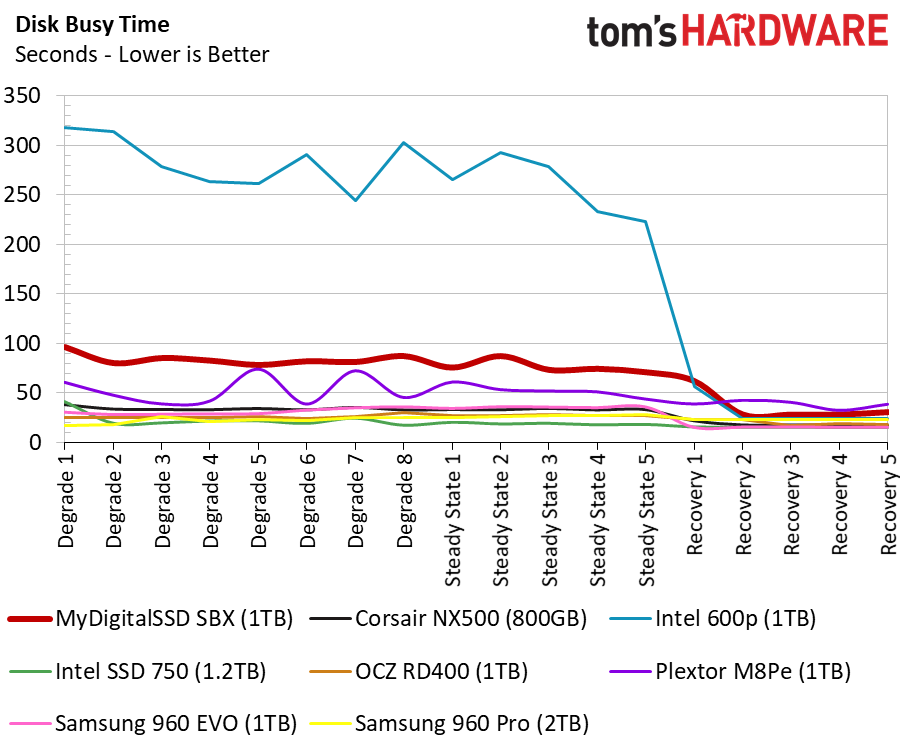MyDigitalSSD SBX NVMe SSD Review
Why you can trust Tom's Hardware
1TB Benchmark Results
Comparison Products
We mixed a popular high-performance NVMe SSD with mainstream and entry-level products for these tests. In the coming months, every drive in these tests will be discontinued by the manufacturer and replaced with new 64-layer TLC-based models. You will still be able to buy the drives, but the companies will stop manufacturing them. We suspect it will take many months for the channel to sell off the overstock, but some products will sell out faster than others.
There are fewer 1TB-class NVMe products than the other capacities because the NAND shortage hit high-capacity NAND packages the hardest. M.2 SSDs have less surface area to mount the packages, which makes high-density packages a must. We recently reviewed a 1TB SATA SSD review that had sixteen NAND packages with two die per package. The net result was very good performance, but it's impossible to spread the die out like that on a small 22mm by 80mm form factor M.2 SSD.
MyDigitalSSD will release a high-performance NVMe SSD using the Phison E12 controller later this year.
Sequential Read Performance
To read about our storage tests in-depth, please check out How We Test HDDs And SSDs. We cover four-corner testing on page six of our How We Test guide.


The MyDigitalSSD SBX has better low queue depth (QD) sequential performance than the Intel 600p. The 600p takes a slight lead above QD4, but outside of burst activity, that is higher than a normal desktop workload.
Sequential Write Performance


The SBX outperforms the 600p in sequential writes across the entire QD range. There is more to the story than just the performance, though. We found it difficult to push the SBX into thermal throttling. The 600p, as well as many other products using the SM2260 controller, can suffer from performance loss due to excessive heat generation during heavy use.
Random Read Performance



Random read performance is the most important differentiator between the entry-level NVMe SSDs. The SBX breaks into the 10,000 IOPS range that separates good products from the less desirable ones. The Intel 600p was a favorite, but only for its price. The SBX offers increased performance in areas that directly impact the user experience, but it comes at a similar price point.
Get Tom's Hardware's best news and in-depth reviews, straight to your inbox.
Random Write Performance


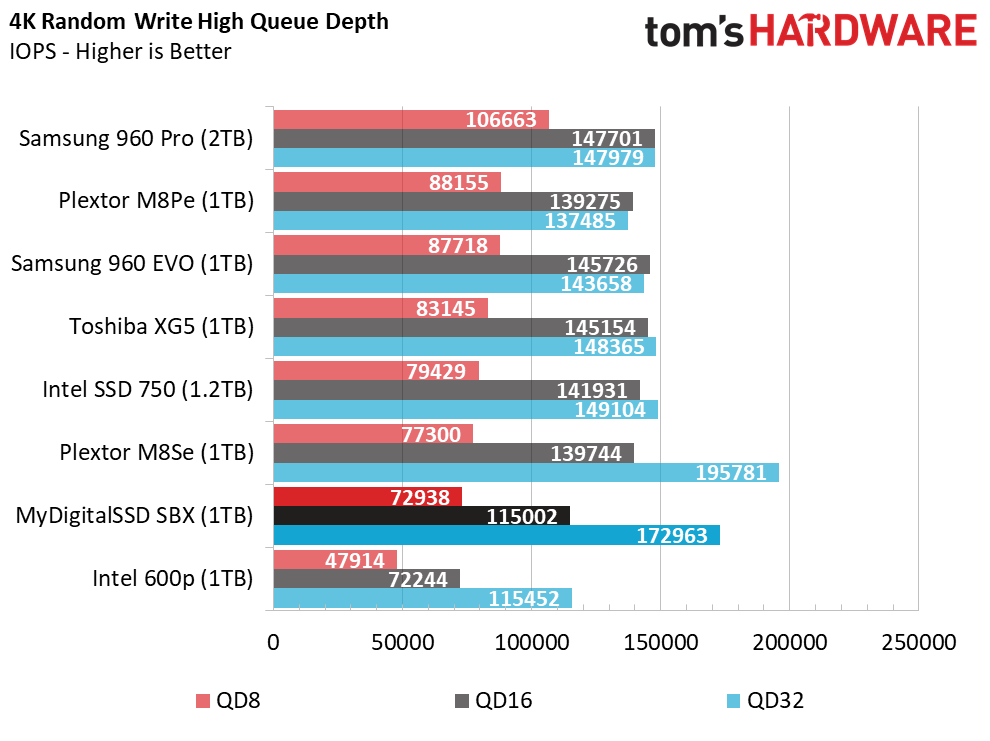
Some products deliver outstanding random write results, but with low-cost models, we're just looking to match or exceed SATA drives. Most modern SSDs provide more random write performance than you can actually use. It's all about latency, but the operating system and other factors present bottlenecks that prevent improvements.
70% Mixed Sequential Workload
We describe our mixed workload testing in detail here and describe our steady state tests here.


The SBX uses Toshiba's new 64-layer TLC flash. That's the same flash in the XG5 NVMe SSD that performed so well in our mixed sequential test. The SBX trails only the XG5 in this test. It's odd to find a true entry-level product nearly leading a significant performance category, but the SBX is right up there thanks to BiCS flash.
70% Mixed Random Workload


The Phison PS5008-E8 controller suffers from low write performance, and that drags down the mixed random results even though only 30% of the workload consists of write data. We often dismiss random write performance, but it does have an impact in other areas that are important during heavy multitasking.
Sequential Steady-State

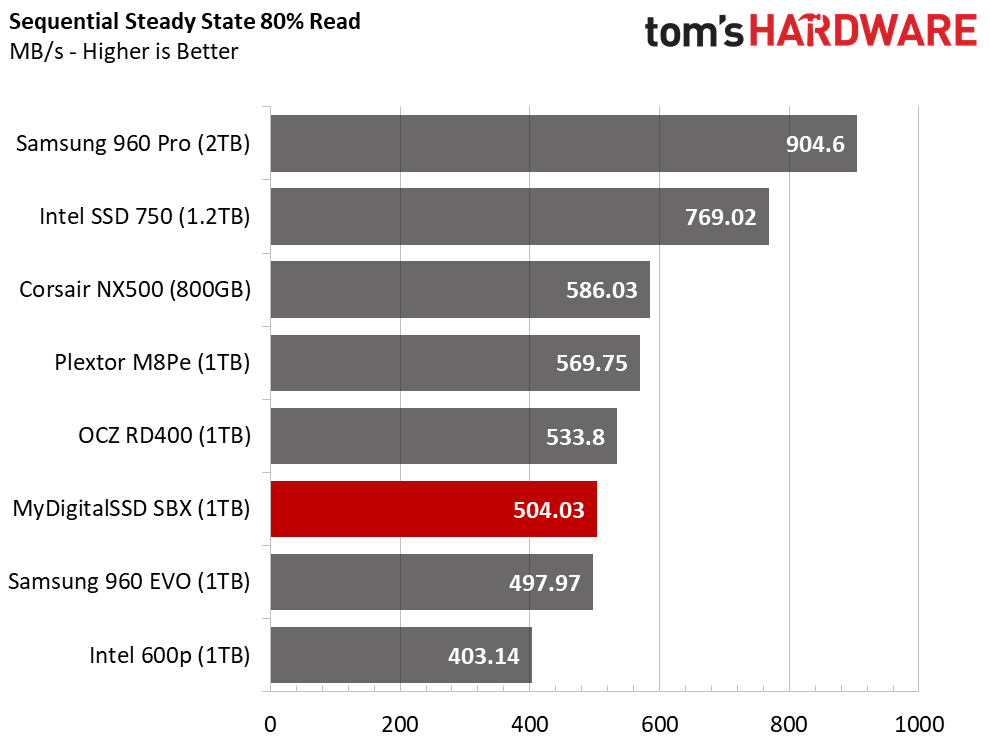

We expect workstation-class performance from SSDs using the NVMe protocol over the high-speed PCIe bus. Planar TLC NAND and Micron's first-generation 3D TLC ended those expectations. The new 64-layer TLC from all the fabs offers increased performance, but the controller still has to operate efficiently under severe conditions. Paying more for an NVMe SSD now, and into the foreseeable future, means getting more processor cores that help sustain high performance during demanding background activities. The dual-core SBX controller is on the low side of the processing power curve, so its sustained write performance in steady-state conditions is lower than some previous-generation products.
Random Steady-State

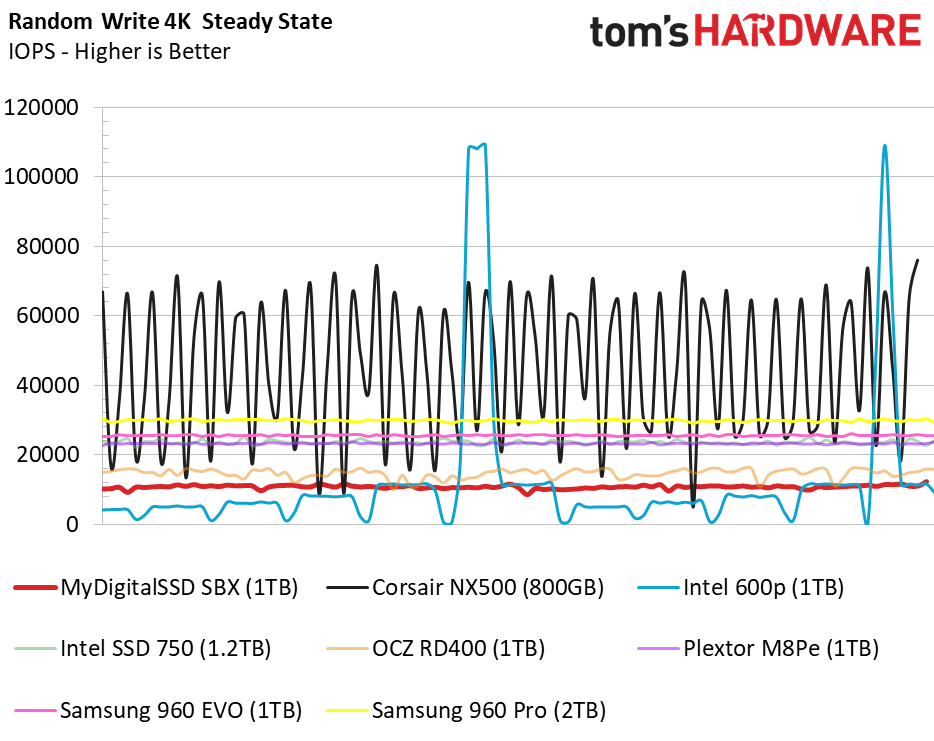
The SBX delivers consistent performance thanks to the new flash. The random steady-state test highlights the unwavering performance. The drive even delivers better performance under these conditions than the best SATA products on the market.
PCMark 8 Real-World Software Performance
For details on our real-world software performance testing, please click here.

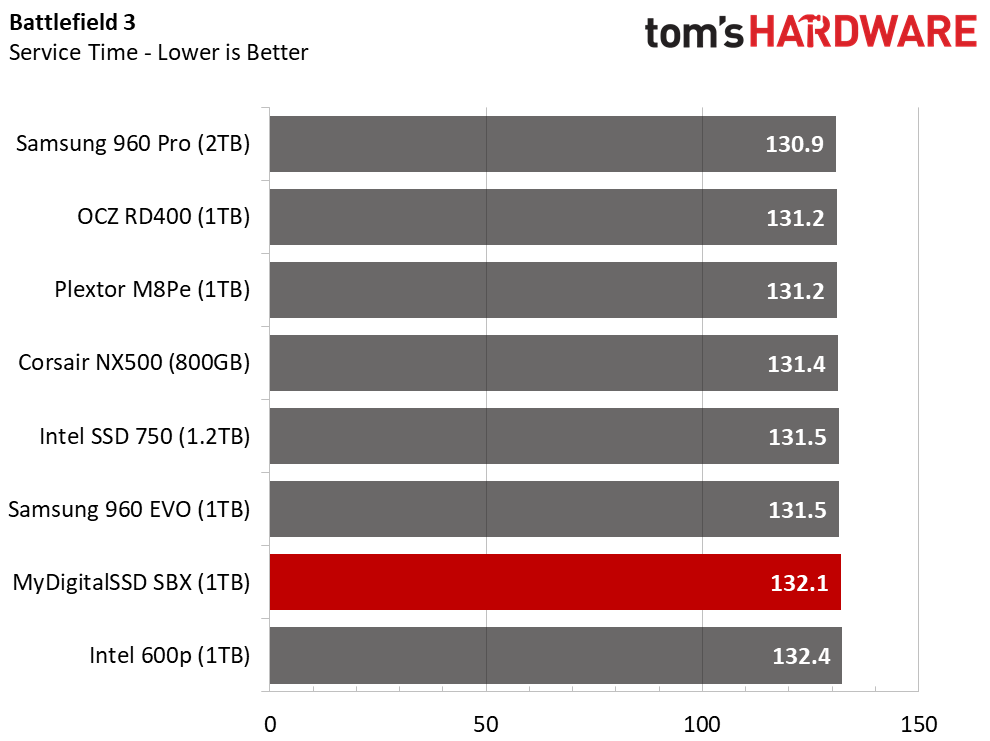



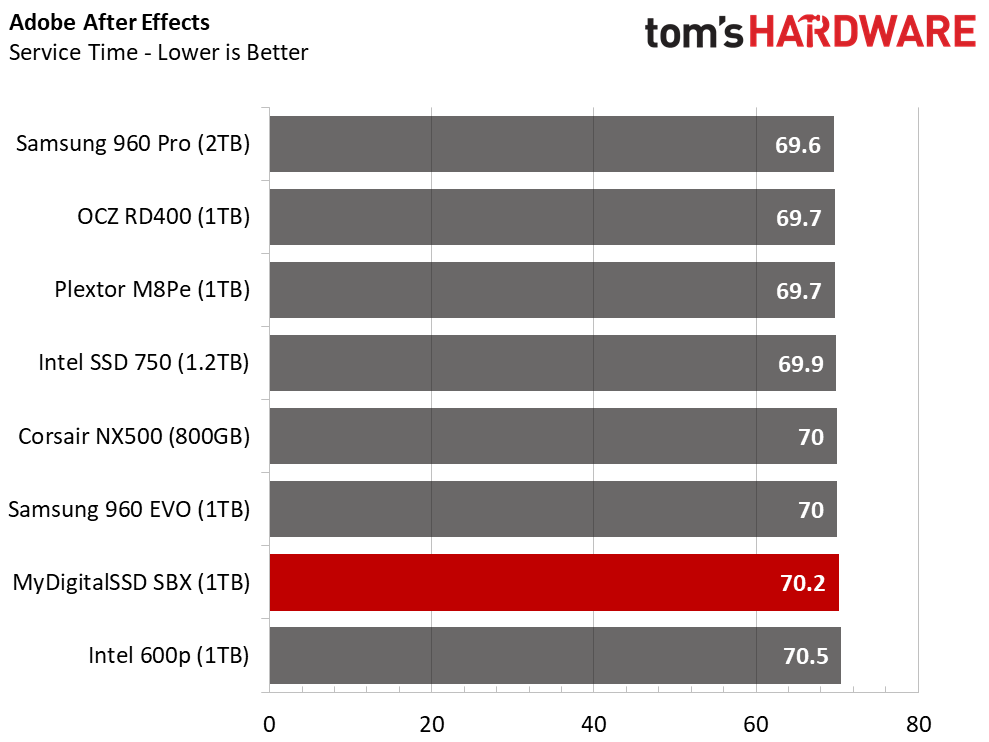




Across the board, the SBX outperforms the Intel 600p in real-world applications.
Application Storage Bandwidth
The average throughput score gives us a better look at the NVMe SSD performance hierarchy with a broad range of applications. The SBX is faster than the 600p under very light workloads, but it trails the rest of the test pool.
PCMark 8 Advanced Workload Performance
To learn how we test advanced workload performance, please click here.

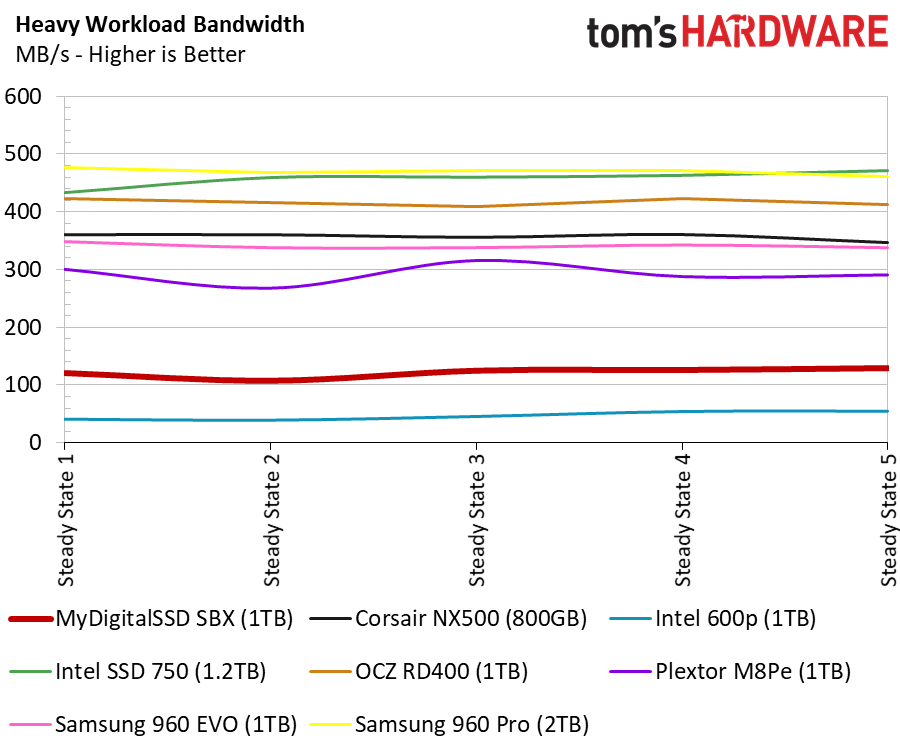

Like all SSDs, the SBX suffers degraded performance after very heavy use. Unfortunately, the dual-core processor needs more time to recover after a sustained heavy workload. The MyDigitalSSD SBX doesn't fully recover with five minutes of idle time between each pass in the recovery stage.
Total Service Time


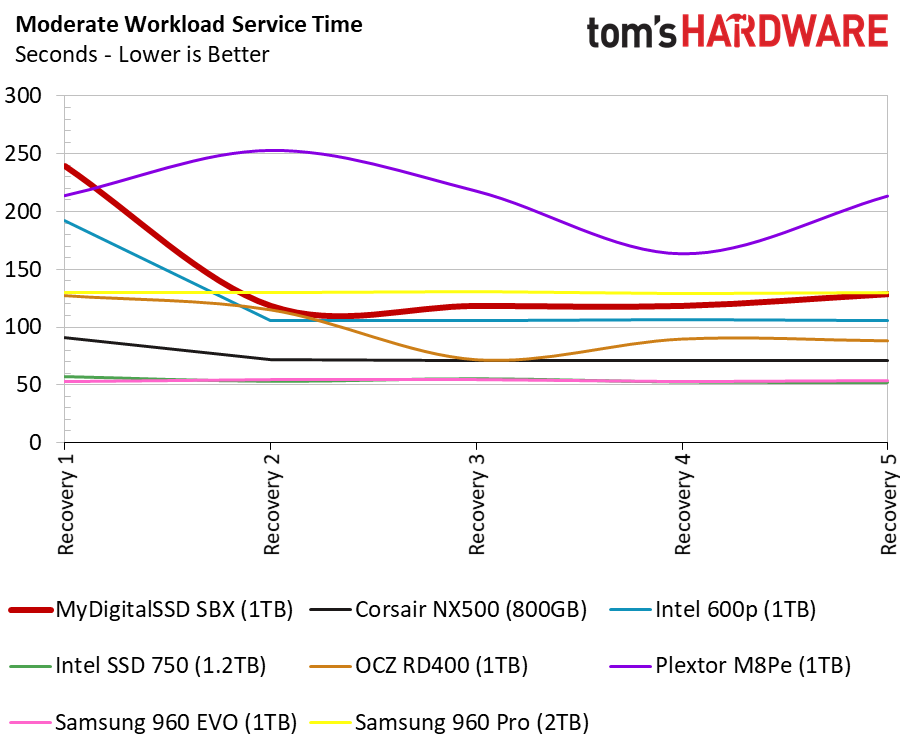
The 600p has a slightly better service time during recovery, but the SBX regains its composure after the drives settle.
Disk Busy Time
The disk busy time test measures how long the drives work to complete each series of tasks. This data gives us an early look at power consumption when a drive is fully active and not in a reduced power state. This test also shows us how efficient the drive is at running basic desktop workloads. The MyDigitalSSD SBX takes more time than most of the drives, but the Intel 600p is much worse.
BAPCo SYSmark 2014 SE Responsiveness Test


The user experience with the 600p and the SBX is nearly identical. The SYSmark 2014 SE Responsiveness Test uses web browsing and typical office applications to generate a score based on latency, completion time, and power use. The SBX's PCIe 3.0 x2 interfere gives it a big power advantage at the system level.
BAPCo MobileMark 2012.5 Notebook Battery Life


SSD power consumption is a complicated issue. Some reviews measure power during the basic four-corner tests, while others present consumption at idle or in one of the many sleep states. SSDs generally consume the most power during background actives while the controller frantically shuffles data, rereads blocks to refresh the cells, or transfers data from the SLC cache to the long-term TLC storage.
While a notebook is on battery power, the CPU, system memory, and interfaces all run in a reduced power state. With default power settings, the SSD is not as fast or as responsive under these conditions. The MyDigitalSSD SBX delivers the same battery time as the Intel 600p.
MORE: Best SSDs
MORE: How We Test HDDs And SSDs
MORE: All SSD Content
Current page: 1TB Benchmark Results
Prev Page Features & Specifications Next Page 512GB Benchmark Results
Chris Ramseyer was a senior contributing editor for Tom's Hardware. He tested and reviewed consumer storage.
-
2Be_or_Not2Be Nice review! There are always products that could have been included, like the Intel 760p.Reply
Yeah.... based on the performance & overall picture - it's a "pass" for me. I'd stick with the BPX or the other higher performing NVMe drives. -
Brian_R170 Totally agree on the Intel 760p missing from the comparisons. Curiously enough, if you go look at the 512MB 760p review from a few weeks ago, the MyDigitalSSD SBX is included on a couple of the Bapco graphs, yet the 760p is completely missing from this review. The 512GB 760p appears to be a much better performing product all around and especially at low queue depths, but with a very similar price.Reply -
CRamseyer Reply20734629 said:MyDigitalSSD is the first out of the gate with a retail Phison E80-powered SSD. The SBX is the entry-level successor to the popular BPX and brings more performance to the table.
MyDigitalSSD SBX NVMe SSD Review : Read more
CES played games with our release schedule and the 760p wasn't available when we wrote this one. Going forward both drives will be in the low-cost NVMe charts. -
Kennyy Evony Other drives are not included because this is a paid advertisement by mydigitalssd and they want to make you forget about competition.Reply -
CRamseyer Wait, I thought it was only Intel that paid off Tom's Hardware?Reply
We dropped the ball here but not because we were paid, loyalty to a company or anything nefarious.
I'm dealing with this issue right now in another article that covers RAID. I have to write one today but I can't include another product that is under NDA and coming in a couple of weeks. One article has a NDA date and the other doesn't. Ideally, the non-NDA review will come out first but something may come up, like other NDA reviews in other categories. It happens sometimes.
If you look back at the timing, we had the two CPU vulnerabilities and every project came to a standstill to figure out your exposure. What was the number one reported performance issue in the early news cycle? Storage performance. Sprinkle in CES and it was a perfect storm that we rarely encounter.
-
daglesj The ADATA SX6000 128GB NVMe will push 680MBps Seq Writes and will probably be cheaper.Reply -
ev3rm0r3 For that price point, why.... my 2 year old 961 still lays this down without thinking about it. Call me not impressed with new drives and their price tags.Reply -
jpe1701 I just picked one up for a game drive. They are down to sata prices over on mydigitaldiscount. I have a pm961 for my os and app drive so I didn't need anything that fast for my second slot.Reply




